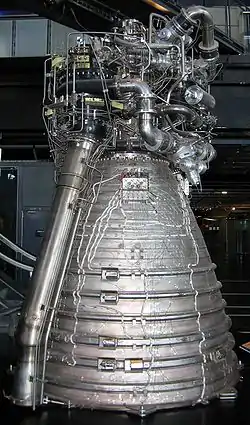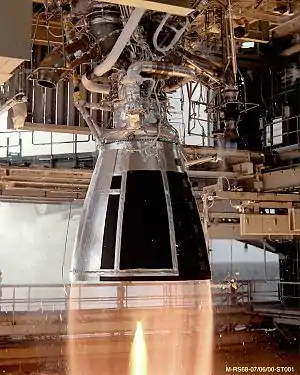Cryogenic rocket engine
A cryogenic rocket engine is a rocket engine that uses a cryogenic fuel and oxidizer, that is, both its fuel and oxidizer are gases liquefied and stored at very low temperatures.[1] These highly efficient engines were first flown on the US Atlas-Centaur and were one of the main factors of NASA's success in reaching the Moon by the Saturn V rocket.[1]
Rocket engines burning cryogenic propellants remain in use today on high performance upper stages and boosters. Upper stages are numerous. Boosters include ESA's Ariane 5, JAXA's H-II, and the United States Delta IV and Space Launch System. United States, Russia, Japan, India, France and China are the only countries that have operational cryogenic rocket engines.
Cryogenic propellants

Rocket engines need high mass flow rates of both oxidizer and fuel to generate useful thrust. Oxygen, the simplest and most common oxidizer, is in the gas phase at standard temperature and pressure, as is hydrogen, the simplest fuel. While it is possible to store propellants as pressurized gases, this would require large, heavy tanks that would make achieving orbital spaceflight difficult if not impossible. On the other hand, if the propellants are cooled sufficiently, they exist in the liquid phase at higher density and lower pressure, simplifying tankage. These cryogenic temperatures vary depending on the propellant, with liquid oxygen existing below −183 °C (−297.4 °F; 90.1 K) and liquid hydrogen below −253 °C (−423.4 °F; 20.1 K). Since one or more of the propellants is in the liquid phase, all cryogenic rocket engines are by definition either liquid-propellant rocket engines or hybrid rocket engines.[2]
Various cryogenic fuel-oxidizer combinations have been tried, but the combination of liquid hydrogen (LH2) fuel and the liquid oxygen (LOX) oxidizer is one of the most widely used.[1][3] Both components are easily and cheaply available, and when burned have one of the highest enthalpy releases in combustion,[4] producing a specific impulse of up to 450 s at an effective exhaust velocity of 4.4 kilometres per second (2.7 mi/s).
Components and combustion cycles
The major components of a cryogenic rocket engine are the combustion chamber, pyrotechnic initiator, fuel injector, fuel and oxidizer turbopumps, cryo valves, regulators, the fuel tanks, and rocket engine nozzle. In terms of feeding propellants to the combustion chamber, cryogenic rocket engines are almost exclusively pump-fed. Pump-fed engines work in a gas-generator cycle, a staged-combustion cycle, or an expander cycle. Gas-generator engines tend to be used on booster engines due to their lower efficiency, staged-combustion engines can fill both roles at the cost of greater complexity, and expander engines are exclusively used on upper stages due to their low thrust.
LOX+LH2 rocket engines by country
Currently, six countries have successfully developed and deployed cryogenic rocket engines:
| Country | Engine | Cycle | Use | Status |
|---|---|---|---|---|
| RL-10 | Expander | Upper stage | Active | |
| J-2 | Gas-generator | lower stage | Retired | |
| SSME | Staged combustion | Booster | Active | |
| RS-68 | Gas-generator | Booster | Active | |
| BE-3 | Combustion tap-off | New Shepard | Active | |
| BE-7 | Combustion tap-off | Blue Moon (spacecraft) | Active | |
| J-2X | Gas-generator | Upper stage | Developmental | |
| RD-0120 | Staged combustion | Booster | Retired | |
| KVD-1 | Staged combustion | Upper stage | Retired | |
| RD-0146 | Expander | Upper stage | Developmental | |
| Vulcain | Gas-generator | Booster | Active | |
| HM7B | Gas-generator | Upper stage | Active | |
| Vinci | Expander | Upper stage | Developmental | |
| CE-7.5 | Staged combustion | Upper stage | Active | |
| CE-20 | Gas-generator | Upper stage | Active | |
| YF-73 | Gas-generator | Upper stage | Retired | |
| YF-75 | Gas-generator | Upper stage | Active | |
| YF-75D | Expander cycle | Upper stage | Active | |
| YF-77 | Gas-generator | Booster | Active | |
| LE-7 / 7A | Staged combustion | Booster | Active | |
| LE-5 / 5A / 5B | Gas-generator(LE-5) Expander(5A/5B) |
Upper stage | Active |
Comparison of first stage cryogenic rocket engines
| model | SSME/RS-25 | LE-7A | RD-0120 | Vulcain2 | RS-68 | YF-77 |
|---|---|---|---|---|---|---|
| Country of origin | ||||||
| Cycle | Staged combustion | Staged combustion | Staged combustion | Gas-generator | Gas-generator | Gas-generator |
| Length | 4.24 m | 3.7 m | 4.55 m | 3.00 m | 5.20 m | 4.20 m |
| Diameter | 1.63 m | 1.82 m | 2.42 m | 1.76 m | 2.43 m | - |
| Dry weight | 3,177 kg | 1,832 kg | 3,449 kg | 1,686 kg | 6,696 kg | 1,375 kg |
| Propellant | LOX/LH2 | LOX/LH2 | LOX/LH2 | LOX/LH2 | LOX/LH2 | LOX/LH2 |
| Chamber pressure | 18.9 MPa | 12.0MPa | 21.8 MPa | 11.7 MPa | 9.7 MPa | 10.2 MPa |
| Isp (vac.) | 453 sec | 440 sec | 454 sec | 433 sec | 409 sec | 430 sec |
| Thrust (vac.) | 2.278MN | 1.098MN | 1.961MN | 1.120MN | 3.37MN | 700 kN |
| Thrust (SL) | 1.817MN | 0.87MN | 1.517MN | 0.800MN | 2.949MN | 509.6 kN |
| Used in | Space Shuttle Space Launch System | H-IIA H-IIB | Energia | Ariane 5 | Delta IV | Long March 5 |
Comparison of upper stage cryogenic rocket engines
| RL-10 | HM7B | Vinci | KVD-1 | CE-7.5 | CE-20 | YF-73 | YF-75 | YF-75D | RD-0146 | ES-702 | ES-1001 | LE-5 | LE-5A | LE-5B | |
|---|---|---|---|---|---|---|---|---|---|---|---|---|---|---|---|
| Country of origin | |||||||||||||||
| Cycle | Expander | Gas-generator | Expander | Staged combustion | Staged combustion | Gas-generator | Gas-generator | Gas-generator | Expander | Expander | Gas-generator | Gas-generator | Gas-generator | Expander bleed cycle (Nozzle Expander) |
Expander bleed cycle (Chamber Expander) |
| Thrust (vac.) | 66.7 kN (15,000 lbf) | 62.7 kN | 180 kN | 69.6 kN | 73 kN | 200 kN | 44.15 kN | 78.45 kN | 88.26 kN | 98.1 kN (22,054 lbf) | 68.6 kN (7.0 tf)[5] | 98 kN (10.0 tf)[6] | 102.9 kN (10.5 tf) | r121.5 kN (12.4 tf) | 137.2 kN (14 tf) |
| Mixture ratio | 5.5:1 or 5.88:1 | 5.0 | 5.8 | 5.05 | 5.0 | 5.2 | 6.0 | 5.2 | 6.0 | 5.5 | 5 | 5 | |||
| Nozzle ratio | 40 | 83.1 | 100 | 40 | 80 | 80 | 40 | 40 | 140 | 130 | 110 | ||||
| Isp (vac.) | 433 | 444.2 | 465 | 462 | 454 | 443 | 420 | 438 | 442 | 463 | 425[7] | 425[8] | 450 | 452 | 447 |
| Chamber pressure :MPa | 2.35 | 3.5 | 6.1 | 5.6 | 5.8 | 6.0 | 2.59 | 3.68 | 7.74 | 2.45 | 3.51 | 3.65 | 3.98 | 3.58 | |
| LH2 TP rpm | 90,000 | 42,000 | 65,000 | 125,000 | 41,000 | 46,310 | 50,000 | 51,000 | 52,000 | ||||||
| LOX TP rpm | 18,000 | 16,680 | 21,080 | 16,000 | 17,000 | 18,000 | |||||||||
| Length m | 1.73 | 1.8 | 2.2~4.2 | 2.14 | 2.14 | 1.44 | 2.8 | 2.2 | 2.68 | 2.69 | 2.79 | ||||
| Dry weight kg | 135 | 165 | 550 | 282 | 435 | 558 | 236 | 550 | 242 | 255.8 | 259.4 | 255 | 248 | 285 |
References
- Bilstein, Roger E. (1995). Stages to Saturn: A Technological History of the Apollo/Saturn Launch Vehicles (NASA SP-4206) (The NASA History Series). NASA History Office. pp. 89–91. ISBN 0-7881-8186-6.
- Biblarz, Oscar; Sutton, George H. (2009). Rocket Propulsion Elements. New York: Wiley. p. 597. ISBN 0-470-08024-8.
- The liquefaction temperature of oxygen is 89 kelvins, and at this temperature it has a density of 1.14 kg/l. For hydrogen it is 20 K, just above absolute zero, and has a density of 0.07 kg/l.
- Biswas, S. (2000). Cosmic perspectives in space physics. Bruxelles: Kluwer. p. 23. ISBN 0-7923-5813-9. "... [LH2+LOX] has almost the highest specific impulse."
- without nozzle 48.52kN (4.9 tf)
- without nozzle 66.64kN (6.8 tf)
- without nozzle 286.8
- without nozzle 291.6


